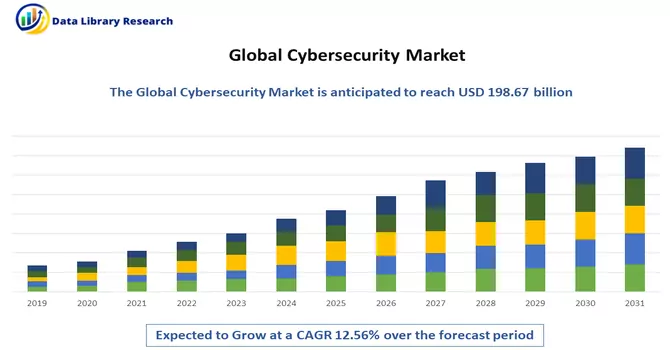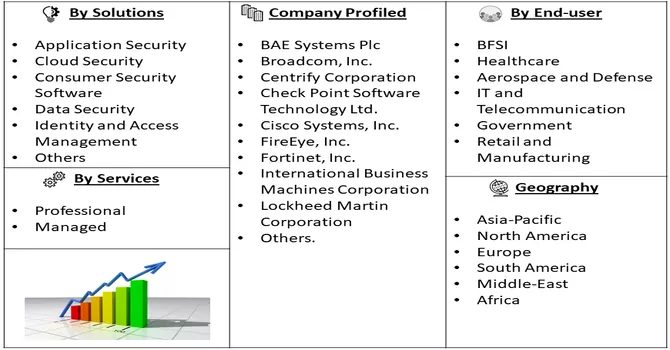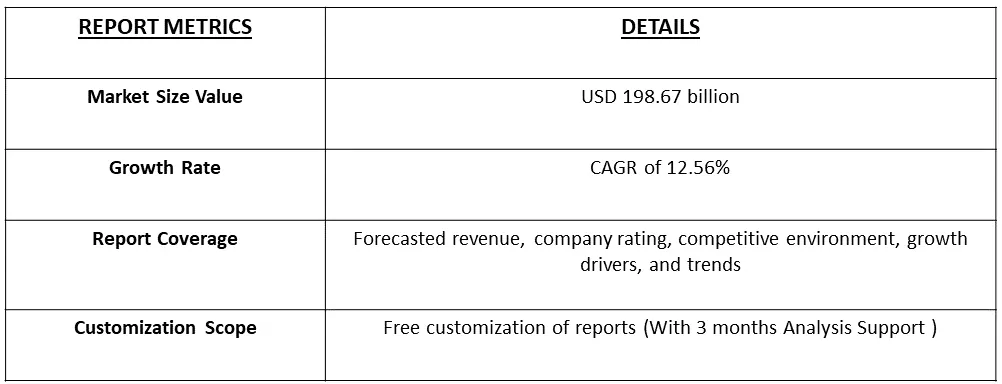The Cybersecurity Market size is estimated at USD 198.67 billion in 2023 and is expected to register a CAGR of 12.56% during the forecast period (2024-2031).

Get Complete Analysis Of The Report - Download Free Sample PDF
Cybersecurity, short for "cybersecurity measures" or "cybersecurity practices," refers to the body of technologies, processes, practices, and measures designed to protect computer systems, networks, data, and digital information from unauthorized access, attacks, damage, or theft. The goal of cybersecurity is to safeguard the confidentiality, integrity, and availability of information technology assets.
The factors that are driving the growth of the studied market are the rising frequency and sophistication of cyber threats, including malware, ransomware, phishing, and advanced persistent threats (APTs), which drive the demand for robust cybersecurity solutions to protect against evolving cyber risks. Moreover, The ongoing digital transformation across industries, with increased reliance on cloud computing, IoT (Internet of Things), and interconnected systems, creates an expanded attack surface. Organizations invest in cybersecurity to secure digital assets and ensure the resilience of digital infrastructure.
Market Segmentation: The Cybersecurity Market is Segmented by Product Type (Solutions (Application Security, Cloud Security, Consumer Security Software, Data Security, Identity and Access Management, Infrastructure Protection, Integrated Risk Management, Network Security Equipment), Services (Professional, Managed)), by Deployment (On-premise, and Cloud), by End-user Industry (BFSI, Healthcare, Aerospace and Defense, IT and Telecommunication, Government, Retail, and Manufacturing), by Geography (North America, Europe, Asia-Pacific, and Rest of the World (Latin America, Middle East and Africa)). The market sizes and forecasts are provided in terms of value in USD for all the above segments.

For Detailed Market Segmentation - Download Free Sample PDF
The market trends that are contributing to the growth of the studied market are the shift to remote work and the widespread use of mobile devices increase the complexity of securing corporate networks. Cybersecurity solutions that provide secure access, endpoint protection, and mobile device management become crucial in this distributed work environment. Also, government initiatives to enhance cybersecurity and the introduction of regulations that mandate cybersecurity practices in critical sectors contribute to increased investment in cybersecurity solutions by organizations seeking to comply with regulatory requirements.
Market Drivers:
Advancements in Emerging Technologies
The ongoing advancements in emerging technologies, including Artificial Intelligence (AI), Machine Learning (ML), big data analytics, Internet of Things (IoT), 5G, edge computing, and cloud computing, are proving to be instrumental for market players in the cybersecurity landscape. This technological evolution empowers companies to introduce innovative solutions, attracting potential business clients and diversifying their revenue streams. A compelling example of leveraging cutting-edge technology in the cybersecurity domain is evident in the launch of Broadcom Inc.'s Adaptive Protection in June 2021. This security solution is an integral part of Symantec's Endpoint Security Solution. What sets this solution apart is its foundation in ML technology, enabling the delivery of customized and automated enhanced security against cyber-attacks. Notably, the implementation of AI plays a pivotal role in tailoring the endpoint security measures to the specific needs and vulnerabilities of each client.
The key benefits offered by such technologically advanced solutions include heightened security measures and the automation of responses to cyber threats. Moreover, these solutions contribute to cost savings for customers by optimizing endpoint security through the intelligent customization made possible by AI. This not only fortifies cybersecurity defences but also demonstrates the potential for technology to drive operational efficiency and effectiveness. As the cybersecurity landscape continues to evolve, the incorporation of AI and ML technologies becomes a critical differentiator for market players. These technologies enable adaptive and proactive security measures, ensuring that cybersecurity solutions are not only responsive but also predictive in addressing the ever-changing threat landscape. The convergence of AI, ML, and other emerging technologies is poised to play a pivotal role in shaping the future of cybersecurity, providing more robust and intelligent defences against cyber threats.
Emergence of Highly Integrated Systems
The increased adoption of mobile devices, the expansion of electronic communication channels, and the widespread use of social media platforms have expanded the attack surface for cyber threats. Furthermore, the growing reliance on Big Data for decision-making processes amplifies the importance of safeguarding sensitive information. In response to these challenges, organizations and governments recognize the need for robust cybersecurity solutions that can proactively address the shifting cyber threat landscape. Governments, in particular, have escalated their investments in cybersecurity solutions to protect devices and confidential data from the escalating threat of cyberattacks. The recognition of cybersecurity as a critical aspect of national security has led to increased spending on advanced technologies and initiatives aimed at fortifying the defence against cyber threats. This financial commitment not only supports the development and deployment of sophisticated cybersecurity measures but also propels the overall growth of the cybersecurity market. Thus, such factors are expected to drive the growth of the studied market over the forecast period.
Market Restraints:
Cybersecurity Market Data Breeching
Data breaches have the potential to impede the growth of the cybersecurity industry in several ways, creating challenges and prompting a reassessment of security strategies. High-profile data breaches erode public trust in the affected organizations. When consumers and businesses lose confidence in the ability of entities to protect their sensitive information, there may be hesitancy to adopt new technologies or services, impacting the growth prospects of cybersecurity solutions. Data breaches often lead to heightened regulatory scrutiny and the introduction of stricter compliance requirements. As governments and regulatory bodies respond to breaches with more robust data protection regulations, organizations may face additional compliance burdens, potentially slowing down innovation and growth. Thus, such factors are expected to slow down the growth of the studied market over the forecast period.
The COVID-19 pandemic has significantly impacted the cybersecurity landscape, introducing new challenges and amplifying existing threats as organizations adapted to remote work, increased digitalization, and heightened cyber vulnerabilities. The pandemic created a fertile ground for cybercriminals to exploit vulnerabilities. The increased reliance on digital platforms and remote collaboration tools led to a surge in phishing attacks, ransomware incidents, and other cyber threats targeting individuals and organizations. The healthcare sector, on the frontline of the pandemic response, became a prime target for cyberattacks. Cybercriminals targeted healthcare organizations with ransomware attacks, data breaches, and disruptions to healthcare services, underscoring the need for robust healthcare cybersecurity solutions. Thus, the COVID-19 pandemic reshaped the cybersecurity landscape, highlighting vulnerabilities, accelerating digital transformation, and driving increased awareness of the importance of robust cybersecurity measures. The evolving threat landscape has prompted organizations to adapt and invest in cybersecurity solutions that address the unique challenges posed by the pandemic-driven changes in work dynamics and digital reliance.
Segmental Analysis:
Data Security Segment is Expected to Witness Significant Growth Over the Forecast Period
Data security is a critical aspect of cybersecurity, focusing on the protection of sensitive and valuable information from unauthorized access, disclosure, alteration, or destruction. In the context of cybersecurity, data security is a fundamental component, as the integrity and confidentiality of data are essential for maintaining the overall security posture of organizations. Data security ensures the confidentiality of information by employing encryption mechanisms. Encryption converts data into a secure format that can only be accessed by authorized individuals or systems, preventing unauthorized parties from understanding or utilizing the information. Data security involves the development and implementation of incident response plans. In the event of a security incident, organizations must be able to respond promptly, mitigate the impact, and conduct forensics to understand the nature of the breach. Thus, owing to such advantages, the segment is expected to witness significant growth over the forecast period.
Cloud Segment is Expected to Witness Significant Growth Over the Forecast Period
The Cloud-based segment is a pivotal component within the cybersecurity landscape, representing a transformative shift in how organizations approach and implement their cybersecurity strategies. This segment encompasses security solutions and services delivered through cloud computing platforms, providing a dynamic and scalable approach to addressing the evolving challenges of cyber threats. Cloud-based cybersecurity offers numerous advantages, including scalability, flexibility, and cost-effectiveness. Organizations can scale their cybersecurity infrastructure based on their evolving needs and pay for services on a subscription or usage-based model. As organizations migrate their workloads to the cloud, ensuring the security of these cloud-based applications and services becomes paramount. Cloud security solutions protect against various threats, including unauthorized access, data breaches, and insider threats. Thus, owing to such advantages, the segment is expected to witness significant growth over the forecast period.
IT and Telecommunication Segment is Expected to Witness Significant Growth Over the Forecast Period
The intersection of Information Technology (IT) and Telecommunication plays a crucial role in shaping the landscape of cybersecurity. As organizations increasingly rely on interconnected systems, cloud computing, and digital communication channels, the need for robust cybersecurity measures within the IT and Telecommunication sectors becomes imperative. The convergence of IT and telecommunications has resulted in highly integrated systems that facilitate seamless communication, data exchange, and collaboration. However, this integration also creates a larger attack surface for cyber threats, necessitating comprehensive cybersecurity strategies. Employee training and awareness programs are essential components of cybersecurity in IT and telecommunications. Human factors, such as social engineering attacks, require a well-informed workforce to recognize and prevent potential security breaches. Thus, owing to such advantages, the segment is expected to witness significant growth over the forecast period.
North America Region is Expected to Witness Significant Growth Over the Forecast Period
North America commanded the largest market share in the cybersecurity landscape, accounting owing to the advancements in cutting-edge technologies such as big data and the Internet of Things (IoT). The proliferation of IT companies in North America, coupled with their diverse business ventures, has created a pressing need for safeguarding endpoint devices against evolving cyber threats. Governments in North America have proactively initiated various initiatives aimed at increasing awareness about cybersecurity among organizations. These efforts also extend to encouraging and supporting entities in adopting robust cybersecurity measures. Recognizing the critical nature of protecting digital assets, both public and private sectors are actively involved in promoting a culture of cybersecurity resilience.
A notable trend driving the cybersecurity market in North America is the integration of artificial intelligence (AI) and machine learning (ML) capabilities into cybersecurity solutions. This strategic move allows organizations to automate their IT security processes, enhancing overall efficiency and responsiveness. For instance, in April 2023, VMware, Inc. unveiled innovative cybersecurity solutions, namely Cloud Configuration and Carbon Black Workload, with the explicit goal of fortifying the security of cloud-native architecture.
These solutions leverage AI and ML capabilities to provide advanced threat detection and response mechanisms. The dynamic nature of the North American cybersecurity landscape is characterized by a continuous cycle of innovation and adaptation to emerging threats. The region's robust IT infrastructure, coupled with the proactive approach of governments and businesses, positions North America as a key driver of market growth. The introduction of advanced cybersecurity solutions with AI and ML functionalities underscores the commitment to staying ahead of the evolving threat landscape. As a result, North America is poised to play a pivotal role in shaping the trajectory of the global cybersecurity market.

Get Complete Analysis Of The Report - Download Free Sample PDF
The cybersecurity market is characterized by the presence of both established global players and regional contenders, contributing to a competitive and dynamic landscape. While the market exhibits high barriers to entry, deterring some potential newcomers, there is notable traction among several new entrants. The competitive nature of the cybersecurity market stems from the critical importance placed on securing digital assets and combating evolving cyber threats. Established global players often possess extensive experience, a wide array of cybersecurity solutions, and a strong market presence. They have solidified their positions through years of innovation, strategic partnerships, and a proven track record in addressing the complex security needs of organizations. Some of the prominent players in the global cybersecurity market include
Recent Developments:
1) In February 2023, Check Point Software Technologies Ltd announced the introduction of Check Point Horizon XDR/XPR, a cooperative cybersecurity solution. It effectively protects organizations against developing cyber threats by smartly correlating data and trying to thwart attacks across all vectors, reducing the impact of threats and making it simple for supervisors and analysts to comprehend and respond to incidents.
2) In December 2022, CrowdStrike announced the development of the CrowdStrike Falcon platform to give the sector's finest adversary-driven external attack surface management (EASM) solution for better adversary intelligence and real-time internet access detection. CrowdStrike Falcon Surface, a standalone module featuring abilities from the recent acquisition of Reposify, was announced as part of the platform update.
Q1. What was the Cybersecurity Market size in 2023?
As per Data Library Research the Cybersecurity Market size is estimated at USD 198.67 billion in 2023.
Q2. At what CAGR is the Cybersecurity market projected to grow within the forecast period?
Cybersecurity Market is expected to register a CAGR of 12.56% during the forecast period.
Q3. What segments are covered in the Cybersecurity Market Report?
By Product Type, By Deployment, End-User and Geography tese are the segments covered in the Cybersecurity Market Report.
Q4. What are the Growth Drivers of the Cybersecurity Market?
Advancements in Emerging Technologies and Emergence of Highly Integrated Systems are the Growth Drivers of the Cybersecurity Market.
Data Library Research are conducted by industry experts who offer insight on industry structure, market segmentations technology assessment and competitive landscape (CL), and penetration, as well as on emerging trends. Their analysis is based on primary interviews (~ 80%) and secondary research (~ 20%) as well as years of professional expertise in their respective industries. Adding to this, by analysing historical trends and current market positions, our analysts predict where the market will be headed for the next five years. Furthermore, the varying trends of segment & categories geographically presented are also studied and the estimated based on the primary & secondary research.
In this particular report from the supply side Data Library Research has conducted primary surveys (interviews) with the key level executives (VP, CEO’s, Marketing Director, Business Development Manager and SOFT) of the companies that active & prominent as well as the midsized organization
FIGURE 1: DLR RESEARH PROCESS

Extensive primary research was conducted to gain a deeper insight of the market and industry performance. The analysis is based on both primary and secondary research as well as years of professional expertise in the respective industries.
In addition to analysing current and historical trends, our analysts predict where the market is headed over the next five years.
It varies by segment for these categories geographically presented in the list of market tables. Speaking about this particular report we have conducted primary surveys (interviews) with the key level executives (VP, CEO’s, Marketing Director, Business Development Manager and many more) of the major players active in the market.
Secondary ResearchSecondary research was mainly used to collect and identify information useful for the extensive, technical, market-oriented, and Friend’s study of the Global Extra Neutral Alcohol. It was also used to obtain key information about major players, market classification and segmentation according to the industry trends, geographical markets, and developments related to the market and technology perspectives. For this study, analysts have gathered information from various credible sources, such as annual reports, sec filings, journals, white papers, SOFT presentations, and company web sites.
Market Size EstimationBoth, top-down and bottom-up approaches were used to estimate and validate the size of the Global market and to estimate the size of various other dependent submarkets in the overall Extra Neutral Alcohol. The key players in the market were identified through secondary research and their market contributions in the respective geographies were determined through primary and secondary research.
Forecast Model
